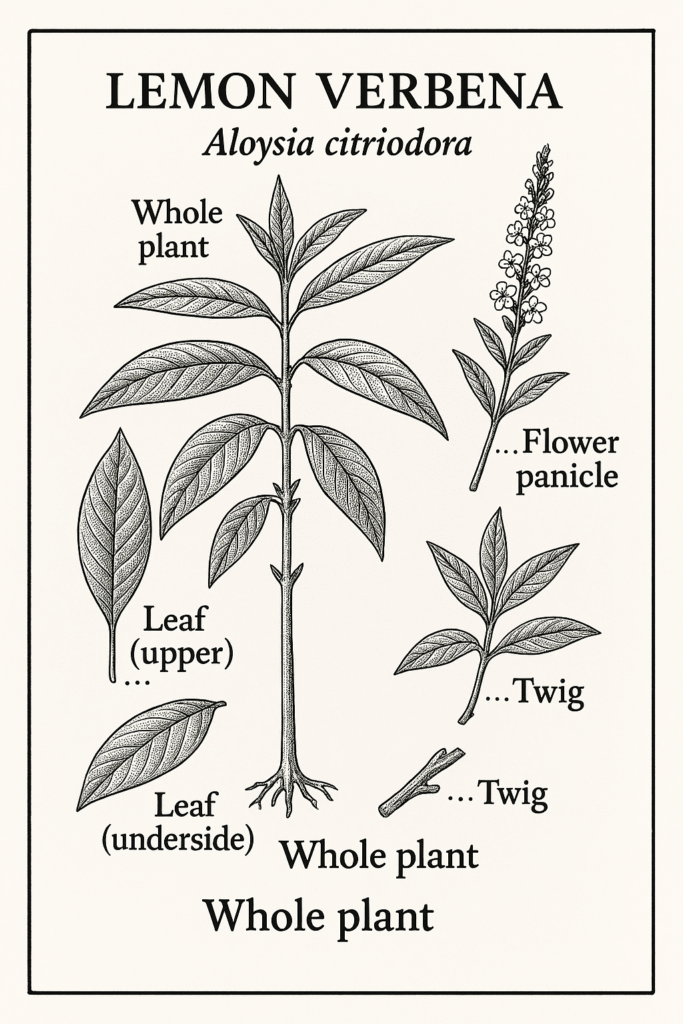Lemon Verbena
Aloysia citrodora Paláu — Materia Medica

Snapshot
Aromatic lemon-scented leaves rich in citral (geranial/neral) and phenylpropanoid glycosides (notably verbascoside). Traditionally used for dyspepsia, gas, and cramping with gentle relaxing effects. Contemporary studies report antioxidant and anti-inflammatory activity; small human trials with standardized extracts suggest benefits for sleep quality and exercise recovery, though evidence remains limited and product-specific.Lemon verbena is a beloved aromatic shrub prized for its bright, lemony leaf and gently relaxing, digestive-soothing nature. The leaf’s essential oils (rich in citral) and phenylpropanoid glycosides—especially verbascoside—give the tea its distinctive bouquet and many of its observed antioxidant and inflammation-modulating actions. Traditionally, it’s taken after meals for bloating, cramping, and nervous stomach, and sipped in the evening to settle a busy mind.
Modern studies of standardized extracts are small but suggest promise: athletes using a verbascoside-standardized lemon verbena extract reported less muscle soreness and quicker recovery, and early work points to sleep-supportive effects and calmative activity. As with many aromatics, whole-leaf infusions remain a gentle, time-honored preparation; tinctures and glycerites are used when a compact format is preferred.
How it’s used
-
Digestive support: aromatic bitter/carminative for gas, mild spasms, and post-meal heaviness.
-
Relaxation & sleep: mild nervine-relaxant; often combined with chamomile, lemon balm, or passionflower.
-
Everyday wellness: pleasant daily tea; pairs well with mint or citrus peel.
Key considerations
Generally food-level safe, but concentrated essential oil can irritate and isn’t used internally. Use caution in pregnancy or when combining with other sedatives due to limited data. As with any herb, stop if irritation or allergy occurs.
Identification & Harvest
Tender, lemon-fragrant shrub (Zones ~8–10; often grown as a container annual elsewhere). Lanceolate, rough leaves borne opposite or in whorls; aroma intensifies when crushed. Harvest leafy tips mid-summer before flowering; avoid woody stems. Dry gently at low heat to preserve volatile oils; store airtight away from light.Preparations
- tea-infusion
- tincture
- glycerite
- syrup
Safety
Culinary amounts are generally well tolerated. Rare allergy or contact dermatitis is possible. The essential oil can irritate skin/mucosa and is not recommended internally. Limited safety data in pregnancy/lactation—use cautiously or avoid. Possible additive sedation with other sedatives; discontinue 1–2 weeks before surgery as a precaution.Related Research
No studies yet.
References
- (2024) Missouri Botanical Garden. Lippia citriodora (syn. Aloysia citrodora) Plant Finder.
- (2018) Rojano-Delgado AM et al. “A comprehensive review on Aloysia citrodora (Lemon verbena): ethnopharmacology, phytochemistry and biological activities.” J Ethnopharmacol.
- (2018) Morillas-Ruiz JM et al. “A lemon verbena extract reduces muscle damage and improves recovery in athletes: a randomized, double-blind, placebo-controlled trial.” J Int Soc Sports Nutr.
- (2023) Drugs.com. Lemon Verbena Monograph.
- (2025) Choi M et al. “Lemon Verbena Extract Enhances Sleep Quality and Duration…” Int J Mol Sci.
- (2021) Valls RM et al. “Lemon verbena polyphenols and appetite/weight control: a randomized trial with hibiscus blend.” Plant Foods Hum Nutr.
Educational content only; not medical advice.
